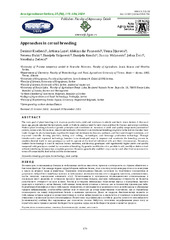Приказ основних података о документу
Approaches in cereal breeding
| dc.creator | Knežević, Desimir | |
| dc.creator | Artiona, Laze | |
| dc.creator | Paunović, Aleksandar | |
| dc.creator | Đurović, Vesna | |
| dc.creator | Đukić, Nevena | |
| dc.creator | Valjarević, Danijela | |
| dc.creator | Kondić, Danijela | |
| dc.creator | Mićanović, Danica | |
| dc.creator | Živić, Jelica | |
| dc.creator | Zečević, Veselinka | |
| dc.date.accessioned | 2023-06-05T07:58:33Z | |
| dc.date.available | 2023-06-05T07:58:33Z | |
| dc.date.issued | 2020 | |
| dc.identifier.issn | 0354-9542 (print) | |
| dc.identifier.issn | 2560-3140 (electronic) | |
| dc.identifier.uri | http://RIVeC.institut-palanka.rs/handle/123456789/667 | |
| dc.description.abstract | The main goal of plant breeding is to improve quality traits, yield and resistance to abiotic and biotic stress factors. A thousand years ago, people selected the best plants, seeds or fruits to produce seed for new crops and food for human and animal nutrition. Modern plant breeding is based on genetic principles and contributes to increases in yield and quality components (contents of protein, amino acids, fat, sucrose, mineral elements etc.). Breeders in conventional breeding programs in the last six decades have made changes to plant phenotypes, significantly improved resistance to diseases, earliness, and frost and drought resistance, and improved scientific farming practices, baking and milling technologies, and beverage production technology. Through bioinformatics and improved technology, breeders have developed ways to improve and accelerate the breeding process to combine desired traits in new genotypes as well to operate at the level of individual cells and their chromosomes. Nowadays, modern biotechnology is used to improve human nutrition, and develop genotypes with significantly higher yields and quality compared with genotypes created by conventional breeding. By genetic modification it is possible to add, modify or delete a trait without interfering between two complete genomes. However, genetically modified crops can be used after their assessment in terms of human health, food safety and the environment. | sr |
| dc.description.abstract | Основни циљ оплемењивања биљака је побољшање особина квалитета, приноса и отпорности на стресне абиотичке и биотичке факторе. Пре хиљаде година људи су бирали најбоље биљке, семе или плод за производњу семена за нове усеве и храну за исхрану људи и животиња. Савремено оплемењивање биљака засновано на генетичким принципима је допринело међусобном повећању приноса и побољшању компонентни квалитета (садржај протеина, аминокиселина, масти, сахарозе, минералних елемената итд.). Оплемењивачи у програмима конвенционалног оплемењивања у последњих шест деценија су остварили промене фенотипова биљака, значајно побољшање отпорности на болести, раностасност, отпорност на мраз и сушу. Такође је остварено побољшање технологије гајења и унапређење примене мера неге и заштите и жетве биљака, побољшање технологије млевења и печења, као и технологије производње пића. Коришћењем биоинформатике и побољшане технологије, оплемењивачи су развили начине за побољшање и убрзавање процеса хибридизације, комбинујући особине које су пожељне да имају новостворени генотипови, као и спровођење инжењеринга на нивоу појединачних ћелија и њихових хромозома. Данас се модерна биотехнологија користи за побољшање исхране људи и за развој генотипова са знатно већим приносом и квалитетом у поређењу са генотиповима створеним у конвенционалном оплемењивању. Генетичком модификацијом могуће је додати, изменити или избрисати (елиминисати) особину без нарушавања два комплетна генома. Међутим, генетички модификовани усеви могу се користити након процене њихове безбедности за здравље људи, оцене безбедности хране и животне средине. | sr |
| dc.language.iso | en | sr |
| dc.publisher | Čačak : Poljoprivredni fakultet, Univerzitet u Kragujevcu | sr |
| dc.relation | info:eu-repo/grantAgreement/MESTD/Technological Development (TD or TR)/31092/RS// | sr |
| dc.rights | openAccess | sr |
| dc.rights.uri | https://creativecommons.org/licenses/by/4.0/ | |
| dc.source | Acta Agriculturae Serbica | sr |
| dc.subject | breeding | sr |
| dc.subject | genotype | sr |
| dc.subject | biotechnology | sr |
| dc.subject | yield | sr |
| dc.subject | quality | sr |
| dc.subject | оплемењивање | sr |
| dc.subject | генотип | sr |
| dc.subject | биотехнологија | sr |
| dc.subject | принос | sr |
| dc.subject | квалитет | sr |
| dc.title | Approaches in cereal breeding | sr |
| dc.type | article | sr |
| dc.rights.license | BY | sr |
| dc.citation.epage | 186 | |
| dc.citation.issue | 50 | |
| dc.citation.spage | 179 | |
| dc.citation.volume | 25 | |
| dc.identifier.doi | 10.5937/AASer2050179K | |
| dc.identifier.fulltext | http://RIVeC.institut-palanka.rs/bitstream/id/2166/bitstream_2166.pdf | |
| dc.type.version | publishedVersion | sr |


